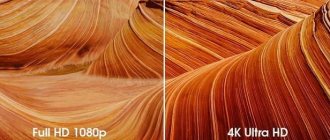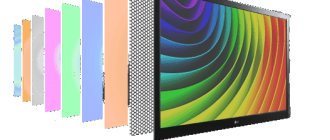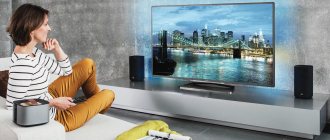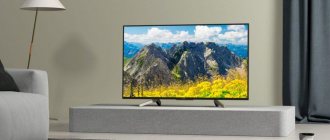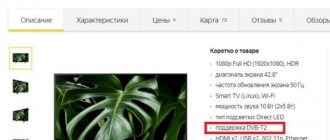When creating new TV models, manufacturers try to use the newest and most modern technologies. Not long ago, the world saw OLED TV models, which differ from IPS and other technologies in high performance and some other characteristics. This is due to the fact that such panels do not require light filters or additional lighting. Also, this feature allows such TVs to be thinner and easier to manufacture than models with IPS technology. But let's first understand what, in general, an OLED display is and how it works.
An OLED TV is a TV whose matrix is mainly composed of carbon-based organic light-emitting diodes. Such screens are often installed in players, phones and other gadgets. It’s not easy for an ordinary person to imagine such a combination, but it works like this: electrical impulses pass through organic light-emitting diodes, causing them to glow. The color that each of these diodes will glow depends on the color of the phosphor with which it is coated. As is customary, this is a red, blue or green phosphor, the combination of which allows you to obtain a huge number of other colors and shades. OLED TV has the shortest response time among all TVs, a wide viewing angle and excellent light transmission. Such screens have many advantages, but also have their disadvantages. Let's discuss all this in order.
How does it all work from the technical side?
In order to create organic light-emitting diodes, thin-film structures with a large number of layers made of polymers are used. When current is applied to the positively charged anode, the electrolytes in the device flow from the negatively charged cathode to the anode. In this case, the cathode gives electrodes to the emissive layer, and the anode takes them from the conductive layer. Thus, the conductive layer becomes positively charged and the emissive layer negatively charged.
Under the influence of voltage, negative and positive particles begin to move towards each other and at certain moments recombine. At the same time, negative particles in such technologies move much faster, and the recombination process occurs near the emission layer. During this process, the energy of the electron is reduced and electromagnetic radiation is released in the visible light region. If the anode is negatively charged, the display will not work, since the electrons will move in a different direction and recombination will not occur.
The anode is often made of indium oxide, which is doped with tin. Such an anode has a high work function, which facilitates the injection of so-called holes into the polymer layer. In addition, it is transparent to visible light. The cathode is often made of calcium or aluminum, since these metals have a low work function.
How OLED TVs are made
Oled TV is manufactured in several stages:
- Selecting a substrate;
- Preparation of the substrate before applying organic light-emitting diodes and other materials to it;
- A control board is manufactured for such radiating sources, both the control system itself and the switching circuits.
- Drawing the structure of certain elements and the organic layer.
- The workpiece is sealed to prevent dust, moisture and air from entering it.
Organic layers, as well as patterns on them, can be applied using several options. Today, all OLED TVs are made using an FMM shadow mask, which stands for Fine Metal Mask. With its help, a template can be applied to organic matter. After this, those areas of the OLED material that are not covered by the template are removed in a vacuum chamber using evaporation. This is the simplest method, but it is not effective enough, especially when producing such large panels.
There are other application methods, such as inkjet printing or laser annealing. Such methods of depositing organic materials are more efficient and thanks to them, creating OLED panels is much easier.
Materials for OLED TVs and their classification
Today, there are several materials for creating OLED panels. They are mainly divided into two types:
- Consisting of large molecules (P-OLED) - such materials are applied using inkjet printing or by centrifugation. R-OLED has enormous technological capabilities and potential.
- Low molecular weight (OLED) - this material helps make OLED displays much better thanks to evaporation technology. Today, scientists are developing other methods of applying organic material.
However, there is another classification, in which the materials used are divided into:
- Phosphorescent materials are associated with the future of lighting panels. Also, with their help it will be possible to create a large OLED display, but so far such materials do not last as long as we would like.
- Fluorescent materials will last longer, but they are not as effective as phosphorescent materials.
Samsung OLED TVs combine these two materials. Thus, OLED TV uses fluorescent light sources for green and blue colors, and phosphorescent ones for red ones.
Selection of 4K OLED TVs LG 2015
Local Dimming Since we covered local dimming and dimming for LCD screens, the same needs to be done for OLED. And as you can already guess from the description of OLED technology, local brightness control is carried out clearly within each pixel of a 4K OLED TV. You can turn the light on or off in one pixel and, as a result, get perfect black color, without the “halo” effect due to light leaking into neighboring pixels.
In reality, we have many local dimming or illumination zones corresponding to the number of individual pixels in a 4K OLED display, i.e. more than 8 million. Yes... LCD/LED TV today can't even come close to this level of accuracy. This technology is used in LG premium OLED TVs LG EF9500 (review here), LG 65EG9600 TV (review here) and in the 2021 LG G6 Signature series.
2021 LG G6 Signature Series.
OLED displays and their types
Monitors of this type are divided into several types, depending on control methods and other features. We can especially highlight the following types of screens:
- PMOLED monitors have controllers for scanning patterns into columns and rows. This means that the pixel that should light up is calculated by row and column. In order for the entire screen to light up, the location of each pixel must be calculated at high speed. OLED displays are mainly used in LG cameras and other small equipment.
- An AMOLED screen, compared to an IPS screen, has the ability to directly control each individual pixel, which speeds up playback. The diagonal of such screens can reach up to 40 inches, but their cost is much higher than that of IPS screens.
- TOLED is a technology that allows you to create transparent screens and achieve the highest level of contrast. In this case, the light can emit up, down or in both directions. The OLED display has only 70% transparency, and this allows it to be used on a store display, in a virtual reality helmet, etc. It can also be combined with many opaque materials that serve as a substrate. Using this technology, it is possible to create devices with a large number of layers or hybrid, for example bidirectional, matrices.
- FOLED. One of the main features of this technology is the ability to create flexible displays by applying organic light-emitting diodes to a flexible plate made of plastic or metal. OLED technology has a particularly thin, light display weight, flexibility, strength and durability.
- SOLED allows you to create folded OLED devices. With this technology, red diodes are arranged in series. At the same time, it is possible to control each element, as well as adjust the color of each pixel by changing the voltage.
Advantages and disadvantages of organic LEDs
OLED devices for displaying digital information have advantages and disadvantages compared to other types of displays.
Advantages of OLED screens over liquid crystal displays (LCD):
- Dimensions – the technology allows the production of displays several millimeters thick.
- Dimensions, panel area - you can make luminous surfaces of a large area, with a diagonal of tens of inches.
- Energy efficiency – OLEDs require significantly less power than other light sources. A disabled LED does not consume electricity – black color.
- Demonstration of deep black color.
- Based on OLED, it is possible to produce flexible screens: watches, monitors, television panels.
- Light weight - allows you to mount devices on thin walls, interior partitions, doors.
- There is no concept of “viewing angles” - the picture is not distorted when viewed from any position.
- Withstands temperatures ranging from -40...+70 °C - can be installed in unheated rooms, outdoors at any time of the year.
- Color accuracy - a wide color gamut and individual control of the glow of each cell guarantee unsurpassed color rendition, soft transitions between different shades and colors.
- Reaction speed - phosphor particles quickly switch, which ensures a high scan update rate. As a result, there are no blurs, frame breaks, or trails behind fast-moving objects.
- Possibility of forming a picture on a transparent display.
- External light sources do not affect the perception of the image from the OLED panel.
- High contrast.
- Low power dissipation.
So far, the main disadvantage of OLED TVs is their high cost. It is decreasing every year, but panels remain more expensive than LCD devices. The second noticeable disadvantage is the operating time of blue LEDs - sometimes it is an order of magnitude less than that of red OLEDs: 15,000 - 20,000 hours versus 130,000 hours. The third disadvantage is sensitivity to high humidity - moisture quickly damages the polymer.
Comparison with other technologies
Compared to QLED technology, OLED loses to it only in the quality of color reproduction, brightness level and, accordingly, the quality of the HDR image. In other respects it is ahead.
Displays based on QNED quantum dots from LG are inferior in image saturation to organic ones and require separate backlighting - which increases the size and cost of the device. They feature a brighter picture with a wider color gamut due to reduced light loss and the level of crosstalk by quantum dots. In QNED panels, the pixels are not turned off, but only shaded, so they require more energy and do not display such deep blacks.
When buying an inexpensive or mid-priced TV, you should pay attention to models with OLED displays. They are superior to their competitors in almost everything and are constantly getting cheaper. Our store consultants will help you choose a model in any price category that can satisfy your needs, they will tell you which budget TV you should buy, where the picture is richer, and which models cannot be repaired.
Benefits of OLED technology
This technology, used to create an OLED display or TV, has a number of advantages:
- Energy efficiency. Such TVs from LG consume a fairly small amount of energy, which is achieved due to the fact that the monitor does not require additional backlighting. This is due to the fact that each LED not only produces a specific color, but also emits light.
- Stylish appearance. Due to the fact that there is no need to additionally install a backlight, the thickness of the screen is also reduced, which means that the weight of the equipment will also decrease. In addition, thanks to the ability to place LEDs on a flexible polymer substrate, curved, transparent or flexible OLED displays can be created.
- Brightness and contrast. Such TVs have a brightness that can reach 100,000 cd/m2. For TVs with other technology, for example, IPS, this level is simply unattainable. The contrast in such TVs is also better. With OLED you can reach 10 million to 1 and that's not the limit.
- Huge viewing angle, that is, you have the opportunity to watch TV from any angle without distorting the picture.
- Maximum response speed up to 0.002 ms. No other TV, including those with IPS technology, can match this speed. Thanks to this speed, the picture is more realistic.
Which is better, OLED or QLED TVs
It is impossible to say unequivocally what is better than OLED or QLED. The answer largely depends on the buyer's requirements. Matrices made using different technologies differ in brightness, color and contrast. QLED can provide up to 2 thousand nits, OLED only 700 nits. Note that for HDR and Dolby Vision to work correctly, it is desirable to have 1 thousand nits. The advantage of OLED is high contrast, natural color reproduction, a wide range of colors, deep blacks.
For many, the deciding factor may be the cost of the TV. QLED models are cheaper. They have better value for money, meaning the image is not so bad that you have to pay much more for it. In any case, a non-specialist will not notice much difference when viewing.
For those who value image quality and don’t mind spending money, it’s better to buy OLED. Although the cheapest of them will still be more expensive than QLED, which is more suitable for lovers of bright pictures.
OLED display and its disadvantages
Despite the positive aspects, such TVs also have their drawbacks, although there are not many of them.
- Short service life of diodes of some colors. For TV, diodes corresponding to RGB colors are used, which are fundamental. The problem with OLED panels is that the blue diodes die before the others. On average, organic LEDs of a given color last no more than 3 years.
- The high price of such screens. This is due to a large number of defects, as well as rather expensive procedures related to quality control. Because of all this, it is difficult to produce monitors with large or medium-sized displays. However, even among small-sized displays there are many defects. Until now, some companies have OLED displays with a large number of shades of green.
OLED TVs and LED. What's the difference between them?
| Qualities | LED | OLED |
| Color space | They have a high color rendering index, like ips. | They convey a greater number of shades that are visible to the human eye. |
| Black level | The black depth is better than other technologies, but the backlight makes it difficult to achieve maximum depth. | The maximum depth of black color is achieved as a result of the fact that absolutely no electricity flows to certain diodes. |
| Brightness | Thanks to the additional backlight, this monitor is brighter. | Due to the constant turning on and off of the diodes, the brightness of the image decreases. |
| Viewing angle | The horizontal viewing angle is 180 degrees, but the vertical one is often not so large, which leads to distortion. | The viewing angle on all sides is 180 degrees, so the picture is not distorted in flat-panel TVs. With curved models the situation is a little worse. |
| Fast response | They have a high response speed, like ips. | They transmit images with a response speed of up to 0.002 ms, which makes movements as clear as possible. |
| Screen sizes | Ice TVs have a wide range of equipment with a large diagonal. | Models with a large diagonal are practically not produced due to the high percentage of defects. |
| Dimensions and power | They have small dimensions, but are significantly inferior to OLED TVs. | Due to the lack of additional lighting, this technique is the thinnest, lightest and most energy efficient. |
| Durability | The diodes in such TVs are the most durable. | Due to problems with the blue diode, which lasts 2-3 years, LG and other companies are trying to find a way out of the situation in various ways. What this will give in the end is still unknown. |
| Price | This TV will cost you half as much as an OLED TV. | A TV with the same diagonal as ice or ips from LG will cost much more due to production features. |
Everything you need to know about OLED TV
Will OLED TVs be the biggest new sensation in the TV world? The growth of this market segment was not as fast as everyone had hoped, but in 2015, models of reasonable dimensions at reasonable prices finally appeared. What's good about OLED? Let's find out.
Save and read later -
Will OLED TVs be the biggest new sensation in the TV world? The growth of this market segment was not as fast as everyone had hoped, but in 2015, models of reasonable dimensions at reasonable prices finally appeared. What's good about OLED? Let's find out.
Televisions have evolved at a rapid pace in recent years; A lot of functions - from 3D to Smart content and 4K Ultra HD resolution - have already become standard for many new models. And although the penetration of another technology can hardly be called rapid, it has finally become quite widespread. We're talking about OLED.
The first OLED TVs hit shelves in early 2013; there were few of them and they were expensive. However, they did give us some idea of what we can expect from the new panels - the picture quality and ultra-thin design inspired enthusiastic expectations, and 4K OLED TVs became the object of desire for many movie fans.
However, the implementation of the promises had to wait another year. First, news broke that Sony and Panasonic were ending their OLED partnership for 4K Ultra HD TV technology, and at CES 2014 only LG unveiled a new line of OLED models.
In 2015 we noticed some progress. LG has released new models of OLED TVs, Sony is “thinking about OLED”; however, we haven’t heard anything from Samsung yet. We also tested the first 4K OLED TV with a curved screen and many smartphones with OLED displays, including the Samsung Galaxy S6 Edge. LG Display, one of the major panel manufacturers, is increasing the efficiency of the OLED production process.
Thus, some giants in the consumer electronics industry are paying quite a lot of attention to OLED technology. So, how does it work, what's good about it, and which OLED TV models can be considered the best? We will tell you about all this and much more.
OLED - what is it?
OLED stands for "Organic Light-Emitting Diode", or "organic light-emitting diode". This technology allows for even thinner TV panels than LCD or plasma, while providing greater efficiency and environmental friendliness. An example is the LG OLED panel, designed for wall installation: its thickness is only 0.97 millimeters.
The technology works as follows: a carbon-based organic film is placed between two conductors and emits light when an electric current passes. This differs from LCD panels, which do not glow themselves - they need a backlight. The pixels of an OLED panel emit light themselves.
There are two types of OLED technologies - passive (Passive-Matrix, PMOLED) and active matrix (Active-Matrix, AMOLED). In active matrix technology, each pixel is turned on and off individually, which is best suited for transmitting motion, and because of this, active matrices are used in the production of televisions.
Currently, only two manufacturers offer OLED TV - LG and Samsung (the latter only for 2013 models). The two companies' technologies are radically different due to their different subpixel structures. Samsung uses a traditional RGB pixel structure in its OLED TVs with red, green and blue colors and no color filters - exactly the same as in plasma models.
In contrast, LG's WRGB technology uses four colors, adding white to the traditional three - which passes through a color filter to create red, green and blue subpixels. LG claims this approach results in higher image brightness.
Advantages of OLED TV
OLED technology has many advantages over LCD and plasma. First of all, these are physical dimensions: OLED models are thinner and lighter than LCDs due to the absence of the need for backlighting.
The second, even more important advantage is image quality. Because OLED pixels emit light themselves, the viewing angle is much wider, and the color palette and contrast are preserved even when the viewing point deviates from the central axis by 90 degrees.
And because each pixel can be turned off individually, OLED TVs are capable of absolute blackness and exceptionally high contrast. In addition, the image is characterized by high brightness and ultra-fast response time of less than 0.01 milliseconds, which virtually eliminates motion blur.
OLED TV problems
However, this technology has not only advantages. OLED TVs are very expensive to produce, and as a result their prices in stores are high: LG's first 55-inch TV, the 55EM970V, cost £10,000 at launch, and the 55EA980W cost £8,000. Samsung's first TV, the KE55S9C, sold for £7,000. Luckily, prices have come down sharply and the LG 55EC930V can be purchased for under £2,000.
In the early years of OLED technology, defect-free product yields were low; For every TV that was suitable for sale, there were a lot of defects. Because of this, production turned out to be very expensive. By reducing the percentage of defects, it was possible to significantly reduce the cost. However, such TVs are still premium.
Another problem with OLED technology was blue pixels. Because the OLED material used to create blue deteriorates faster than red and green, it has a shorter lifespan and the TV's color balance deteriorates over time.
Samsung solved this problem by making the blue pixel twice the size of the others. LG's WRGB system is theoretically free of this flaw; Let's see how it performs in the long term.
Curved TV
The first OLED TVs introduced by Samsung and LG in the UK featured curved screens. Many were skeptical; In our review of Samsung's first OLED TV, we looked at this as both a plus and a minus.
“This is a revolutionary idea,” we noted, “something akin to a concept car: very cool, but not always truly practical.” Due to the curvature of the Samsung TV screen, it is not suitable for wall mounting.
Manufacturers believe that a curved screen improves the viewing experience. Samsung believes it "gives images depth, making them appear more vibrant and lifelike" and "provides an immersive panoramic effect." According to LG, the curvature of the screen "eliminates the problem of image distortion at the edges of the screen and loss of detail."
A marketing trick - or real immersion in the film? One way or another, it's not just OLED TVs that can boast seductive curves: we've already seen curved 4K models with LCD and LED panels, for example, the Samsung UE55JS8500.
Here the picture is exactly the same: the immersion in the action of the film is more complete, and besides, televisions are very impressive in appearance, but they are less suitable for viewing in a group, since their maximum comfort zone is narrower.
Smartphones with curved displays have also become widespread - including the LG G Flex, G Flex 2 and Galaxy S6 Edge - and they arguably make more sense than TVs.
4K OLED? Flexible OLED?
LG was not satisfied with “simple” OLED TVs and released the first 4K OLED model.
But this didn’t seem enough to her: already this year, the first flexible OLED TV will roll off LG’s production lines, designed for those who can’t decide whether to choose a flat or curved screen.
We already saw LG's 77-inch flexible OLED TV in action at CES 2014. When it launches, it will likely cost a lot of money - at least initially.
New OLED TVs for 2015
Should we expect OLED models from other manufacturers in 2015? Looks like there is hope.
The Chinese company Haier at the IFA 2014 exhibition in Berlin announced the release of a new line, which includes a 55-inch Full-HD-OLED TV. We don't yet know whether it will go on sale in the UK and Russia and at what price.
In addition, we can expect another player to appear on the market. TCL has unveiled new technology using "quantum dots" and plans to release an Ultra-HD-4K TV using this technology. According to TCL, the quantum dot screen will cost one-third as much as a comparable OLED screen. Will he be able to make the same impression? Wait and see.
Chinese manufacturer Hisense presented its ULED (Ultra LED) technology, promising to provide OLED-level image quality at a fraction of the price. The 65XT910, the world's first ULED TV, costs £2,200. We expect to get some of the Hisense TVs for testing soon.
Best OLED TVs
LG 65EF950V
Price as tested: £4000
The 65EF950V is the first flat-screen 4K OLED TV we've seen; it immediately made it onto the list of our favorite 4K-OLED models. It is not cheap, but its advantages more than justify even such a high price. Thanks to its flat screen, it has a wider viewing angle than its curved counterparts, and provides superior image quality when viewing HDR content.
LG 55EG960V
Price as tested: £3800
Want to see the best TV of 2015? It is quite possible that this will be the winner of the Award. The first 4K OLED TV in our test labs did not disappoint.
The price is quite high, but the quality comes with it: deep blacks, an energetic color palette and amazing detail.
LG 55EC930V
Price as tested: £2000
The budget segment of the market is also not deprived of attention by LG. This is not a 4K model, which of course makes a big difference; However, does it really matter when you can enjoy true OLED quality at such a modest price.
If you want to get the most out of HD and even SD content, this is the best choice.
Prepared based on materials from the magazine “WHAT HI-FI?”, November 2015
www.whathifi.ru
This article was read 9,962 times
The article is included in the sections:
How to choose. Buyer's GuideUseful Tips
The present and future of OLED TVs
Today, OLED displays are used mainly in various mobile devices. However, this technology is also popular in TV. LG uses it especially actively. Moreover, many of these TVs are already made using modern technologies, that is, organic LEDs are created on the basis of quantum dots, which are better and much cheaper to produce.
Not long ago, LG released a TV with a 77-inch diagonal Ultra HD curved screen and 3D Smart TV function. Moreover, such a TV can receive and play video and other multimedia files from any type of media. In addition, new TVs from LG have an excellent acoustic system and all the above-described advantages of OLED technology. However, it is worth saying that the price of new OLED TVs from LG is quite high, which is the main drawback.
This company also released another OLED TV with a curved screen, which has the same characteristics. It is distinguished by an updated operating system and new WRGB technology, which is distinguished by the presence of an additional white subpixel, which cannot be found on TVs with IPS technology. This technology promises to provide the most realistic, clear and smooth images. In addition, the LG TV has a large number of different settings and interfaces. This model is only 4.3 mm.
In the future, LG promises to produce OLED displays of even larger sizes, as well as to develop color rendering technology and try to increase the service life of organic light-emitting diodes. Also quite promising areas of development are transparent OLED displays that can be built into car glass and windows, rollable screens, as well as lighting devices based on OLED technology. By the way, it is worth noting that some of this has already begun to be gradually applied.
There are also disadvantages to OLED matrices
Of course, there are still disadvantages to OLED technology. Thus, the “blue” pixel lives much shorter than the “green” and “red” ones. But, for example, LG solves this problem by installing a “white” pixel with a color filter system. Such OLED TVs are no longer inferior to widely used technologies in terms of service life.
In addition, OLED technology and production do not stand still. Already, “long-lived” organic diodes are being created and such a “blue” pixel continuously operates for 17.5 thousand hours, which is quite comparable to the service life of LCD and plasma screens.


